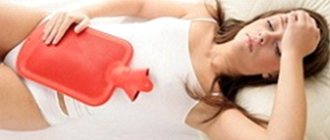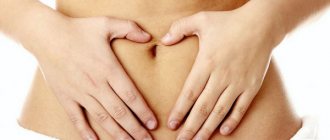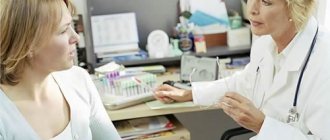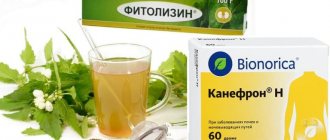One of the common gynecological diseases is salpingoophoritis - inflammation of the uterine appendages. This disease combines damage to the fallopian tubes and ovaries, since it is their combined inflammation that occurs most often. The reason that inflammation of the left ovary or inflammation of the right ovary develops, damage to the fallopian tubes, is exposure to infectious agents. Moreover, the inflammatory process can be caused by both pathogenic microorganisms and opportunistic microorganisms, which can normally be present in the vaginal flora. This pathology is dangerous, since an incompletely cured inflammatory process can cause the development of adhesions, and, as a result, infertility.
Causes of ovarian inflammation
Gynecologists note that oophoritis is a consequence of adnexitis or salpingitis. Doctors note that oophoritis can occur as a consequence of operations, childbirth or abortion. But most often, according to research, the cause is infections and bacteria in opportunistic intestinal flora, purulent diseases and inflammations, vaginal dysbiosis, as well as trichomoniasis and tuberculosis.
If there are sexually transmitted infections in the body and diseases that are not completely cured, then they can provoke the rapid development of oophoritis.
In addition, unfavorable development is facilitated by interruption of sexual rest earlier than expected after pregnancy or abortion, sexual contact without a condom, several sexual partners in a short period of time, and an intrauterine device that a woman wears longer than expected.
Symptoms of inflammation
Inflammation of the ovaries in women (symptoms and treatment can only be determined by a doctor) cannot be independently diagnosed. But you can undergo a timely examination at the first signs and successfully treat the disease without serious consequences.
The article describes common symptoms of ovarian inflammation in women and the main methods of treatment.
You should make an appointment with a doctor if you have the following symptoms:
- strong discharge with pus;
- sex accompanied by cramping and intense pain;
- bleeding in the middle of the menstrual cycle, i.e. when they shouldn't be;
- acute pain in the uterine area, which is also felt in the lower back and sacrum;
- temperature is above normal;
- acute pain on palpation of the uterus.
If, in the presence of the indicated symptoms and diagnosis, it is not cured within 2 weeks or the treatment is carried out incorrectly, then oophoritis will transform into a chronic form.
Its symptoms include:
- Dull pain in the vagina and groin that intensifies before menstruation;
- sexual dysfunction (pain during sex, decreased libido);
- disorders of the cycle and ovarian function;
- regular scanty whitish discharge;
- absence of pregnancy even with regular lovemaking.
Gynecologists note that there is also a subacute form, which is less common than the acute and chronic forms. Typically, the subacute form occurs with tuberculosis and mycosis.
How to determine inflammation yourself
Pelvic inflammatory processes affect various organs: ovaries, fallopian tubes, peritoneal tissue, uterus, cervical canal, cervix or vagina. In 7 out of 10 women with inflammation, adnexitis is detected.
Adnexitis is an inflammatory process that occurs in the uterine appendages: the ovaries and fallopian tubes.
In most cases, the cause of the pathology is an infection that enters the woman’s body through the vagina. Less commonly, the disease is caused by several microorganisms at once. The unique structure of the female genital organs does not allow pathology to be detected immediately. Adnexitis may be asymptomatic or manifest a minor clinical picture. You can detect deviations from the normal state on your own, but a woman can never be sure that she is dealing with inflammation of the appendages unless this is confirmed by laboratory and instrumental methods. Signs of adnexitis are:
- increased body temperature (to high values in the acute stage and low-grade fever in the chronic stage);
- pain in the lower abdomen (increases during sexual intercourse and during bowel movements);
- burning sensation in the genital area (develops due to an imbalance of microflora caused by the proliferation of pathogenic microorganisms);
- strange discharge (vaginal secretion turns green, gray, yellow, purulent and acquires an unpleasant odor);
- enlarged inguinal lymph nodes.
Oophoritis and pregnancy
Neither acute nor chronic forms of oophoritis are an obstacle to pregnancy.
But doctors recommend categorically avoiding conception if you have:
- acute adnexitis;
- purulent oophoritis;
- pyosalpinx;
- abscess and cysts of the appendages;
- tubo-ovarian tumor;
- complicated course of adnexitis (inflammation of the uterine appendages).
If, despite the doctors’ warnings, conception occurs, the following complications are possible:
- tubal or frozen pregnancy;
- spontaneous abortion;
- threat of termination of pregnancy in the 1st-2nd trimester;
- the need to maintain pregnancy in a hospital setting;
- impaired blood flow between the fetus and the uterus, fetal underdevelopment and the threat of infection;
- underdevelopment of the baby;
- lack of breast milk.
If, on the contrary, pregnancy does not occur after a cured disease, then doctors recommend resorting to IVF in this case. It is worth noting that this is an emergency measure when it is not possible to get pregnant after 1-2 years of trying to conceive.
Diagnostics
At the first symptoms of ovarian inflammation in women, you should immediately contact an obstetrician-gynecologist who will prescribe adequate treatment.
Since the symptoms of oophoritis are similar to the symptoms of appendicitis, peritonitis, cysts and endometriosis, to make an accurate diagnosis the doctor may prescribe a comprehensive examination, which includes:
- history taking and examination;
- undergoing tests, transvaginal ultrasound;
- bacteriological and gynecological examinations;
- hysterosalpingoscopy and laparoscopy, which are prescribed in rare cases and are not only an examination, but also an operation.
DLG
Some specialists prescribe what is popularly called intimate warming, and this technique is correctly referred to as DLH - dosed local hyperthermia. This is an auxiliary physiotherapeutic procedure in which heat is treated. It is prescribed for many inflammatory gynecological diseases. For it, a nozzle is taken, which is inserted into the vagina, thereby ensuring local heating of the problem area.
The number of procedures and temperature conditions are assigned in each case individually. But with each subsequent time there is a gradual increase in temperature. The maximum heating level is +54 °C. At the same time, women who have undergone this procedure claim that it does not cause discomfort.
One of the main indications for this method is inflammation of the appendages, regardless of what pathogens it was caused by, whether the cause of the infection is bacteria or viruses. However, there are also contraindications. These include, for example, any neoplasms of the mammary gland and organs of the reproductive system, endometriosis, the presence of cervical erosion, pregnancy. Also, the procedure is not performed during menstruation.
Gynecological massage is also performed using the device used for DLG. The fact is that the device can operate in mechanical vibration mode, and this helps to normalize the function of the ovaries and even allows you to get rid of small and loose adhesions, if any. Gynecological massage also increases the effectiveness of using any medications. But before you sign up for this procedure, you must undergo an examination by a specialist, and the doctor will most likely refer you for an ultrasound of the pelvic organs.
Treatment of acute oophoritis
The doctor prescribes treatment only after a full examination. Treatment of acute oophoritis is carried out only in a hospital in the presence of high temperature. The process is accompanied by the use of antibiotics, immunostimulants, vitamins, vaginal suppositories, antibacterial, antihistamines, painkillers, antifungal drugs and hormonal agents.
The use of the latter is aimed at restoring the normal menstrual cycle. If the disease is in the subacute stage, then physiotherapy may be used.
It is important to note that in no case should acute oophoritis be treated independently with folk remedies without prior consultation with a doctor, since such an attitude towards one’s health is fraught with infertility.
Physiotherapeutic methods for treating inflammation of the appendages
Practice shows that antibiotics do not always help in the treatment of adnexitis, especially when it comes to its chronic form. Therefore, doctors are currently searching for new drugs and effective physiotherapeutic methods.
Among those options that are already widely used today are:
One of the most effective methods for adnexitis is considered to be plasmapheresis, in which the patient’s own plasma is replaced with fresh donor plasma.
This technique is mainly used for long-term chronic forms of inflammation, when internal intoxication syndrome develops and blood microcirculation is disrupted. It is recommended to carry out such procedures in the first phase of the menstrual cycle; the doctor selects the number of sessions individually.
Therapy for chronic inflammation
For chronic inflammation, slightly different treatment methods are used depending on the stage of the disease.
During an exacerbation the following are used:
- antibiotics;
- anti-inflammatory and painkillers;
- enzyme therapy;
- physiotherapy;
- biogenic stimulants;
- balneology;
- surgery in extreme cases.
All treatment methods are aimed at preventing adhesions, which can lead to infertility.
To prevent chronic oophoritis it is necessary:
- visit a gynecologist every six months;
- treat infectious and inflammatory diseases associated with the reproductive sphere;
- exclude casual sex, smoking, alcohol, abortion;
- lead a healthy lifestyle;
- Avoid hypothermia and various mental and physical stress.
Prevention
In order not to think about how to relieve inflammation of the appendages at home in the future, it is necessary to carry out preventive measures. Chronic adnexitis has a tendency to worsen. With the slightest decrease in immunity, all symptoms of inflammation return. This means that even a common cold can worsen a woman’s condition. You can prevent relapses of adnexitis if you follow the following rules:
- visit a gynecologist in a timely manner, take tests and complete the prescribed treatment in full;
- exclude unprotected sexual contacts with frequent changes of partners;
- use high-quality contraceptives (condoms, coils or suppositories);
- maintain personal hygiene, prevent the appearance of thrush;
- protect yourself from hypothermia and colds;
- exclude uncontrolled use of antibiotics;
- lead a healthy lifestyle, give up bad habits.
Symptoms of adnexitis are similar to diseases such as adenomyosis, endometriosis, adhesions in the pelvis, cervical erosion and other pathologies. The disease can be differentiated using ultrasound. If a woman does not want to go to the doctor, but has doubts about her health, then she can simply visit the ultrasound room. It will immediately become clear whether home treatment is needed or whether you can do without it at this stage.
Medications
Ovarian inflammation in women, the symptoms and treatment of which are discussed in the article, is treated by prescribing:
- antibiotics;
- drugs that relieve inflammation;
- stimulants;
- immunomodulators;
- vitamins;
- medications with longidase;
- antihistamines.
Antibiotics are prescribed in the form of tablets, injections and suppositories. Moreover, for treatment either one form can be used at the same time, or several at once. The most effective are cephalosporins, penicillins and tetracyclines.
These substances are contained in Clindacin, Gentamicin, Hemomycin. The drugs are prescribed in parallel with Metronidazole or Trichopolum, the action of which is aimed at stopping the inflammation process.
In most cases, after antibacterial therapy, the microflora in the intestines and vagina is disrupted, so the doctor usually prescribes a course of products containing lactobacilli, for example:
- Acylact;
- Bifidumbacterin;
- Linux;
- Bifiform.
Anti-inflammatory drugs not only suppress the development of the inflammatory process, but also relieve pain. Experts, due to the location of the affected organs, recommend using suppositories. These can be the popular drugs Movalis, Diclofenac or Indomethacin, as well as other less well-known ones.
Another group of drugs is biogenic stimulants. Their goal is to improve tissue trophism and accelerate tissue repair processes, which ensures recovery in the shortest possible time. These products contain aloe extract, but other substances of plant or animal origin may also be present.
Biogenic stimulants improve blood circulation and have virtually no side effects. They are available in injection form.
Immunomodulators strengthen the body's immunity to make it easier for it to tolerate pathological changes. They are usually prescribed for chronic oophoritis. Among the most popular are such drugs in the form of drops as Immunal, Likopid, Interferon, Viferon, Cycloferon and Anaferon.
Vitamin therapy can be prescribed both during treatment and after its completion for preventive purposes. The doctor, depending on your health condition, may prescribe a course of multivitamins or individual ones. For example, E, group B and C for menstrual irregularities. Main form of release: dragees and tablets. The most prescribed drug is Magnesium B6.
If the adhesive process has already begun in the body, then to prevent problems with conception or to prevent infertility, drugs with longidase of the same name are prescribed. The product is available in the form of suppositories, which must be administered every 3 days.
The purpose of antihistamines is to block the functioning of histamine receptors and prevent the initiation of an allergic reaction. The drugs are produced mainly in the form of tablets. The most famous are Cetrin and Suprastin.
Antimycotic drugs are prescribed if the cause of oophoritis is a fungal microflora. Doctors usually prescribe Hexion or Betadine, which come in the form of suppositories.
Oophoritis in any form can be accompanied by pain. To prevent them, doctors prescribe painkillers - Baralgin, No-shpu or Spazmalgon. If the disease is accompanied by fever or temperature, the doctor prescribes antipyretic drugs.
Since in some cases with oophoritis, doctors recommend protection, during illness, to prevent conception, doctors prescribe a course of hormonal medications that will not only protect against unwanted pregnancy, but also cure acute oophoritis. The drug should be taken for approximately 3 months at the same time every day.
Treatment of adnexitis: basic principles
Treatment of adnexitis is a process that requires an integrated approach. First, you need to establish the cause of the disease, which requires laboratory tests, since you need to identify the pathogen and evaluate its resistance to various antibiotics.
Most often, therapy for acute or subacute adnexitis is carried out in a hospital setting, and in the chronic form it is possible to treat it at home. In this case, antibiotics or antibacterial drugs, as well as immunomodulatory, desensitizing and anti-inflammatory drugs are prescribed. This is necessary in order to improve blood microcirculation, relieve pain and inflammation. Physiotherapeutic methods are prescribed only when the temperature becomes normal.
If you consult a doctor in a timely manner, the duration of treatment is 2-3 weeks. Theoretically, it can be treated at home. However, therapy for adnexitis requires bed rest. At home, this is only possible if the family takes on all the responsibilities - cleaning, cooking, etc. Otherwise, there will be no talk of any peace. In addition, it should be remembered that during the treatment of adnexitis, sex is absolutely prohibited.
When treating the chronic form, nonsteroidal anti-inflammatory drugs, immunocorrectors or biostimulants, vitamins, and enzymes are prescribed.
Non-drug treatment methods play an important role. These are, for example, therapeutic exercises, special massage and intimate warming, and other physiotherapeutic procedures. Antibiotics are rarely prescribed for the chronic form - only in cases where pathogenic bacteria that cause the disease have been detected.
Despite the fact that chronic adnexitis occurs in a milder form than acute adnexitis, it can be more difficult to treat, if only because antibiotics practically do not help. Anti-inflammatory drugs and various physiotherapeutic methods remain. These are, for example, ultrasound and magnetic therapy, electrophoresis, and other procedures whose effect is aimed at improving trophism and microcirculation in tissues.
Mud therapy is considered an effective method, but only if the woman does not have benign tumors in the pelvic organs.
Folk remedies
Traditional medicine is no less effective than pharmaceutical advances. But when using them, several rules must be followed, otherwise serious health consequences may occur.
- Traditional medicine recipes cannot replace medical treatment;
- they cannot be used for acute oophoritis.
Types of folk remedies used:
- douching solutions;
- healing ointment;
- teas
The douching procedure can be performed twice a day - in the morning after waking up and in the evening before going to bed:
- 1 tbsp. young blueberry leaves pour 1 tbsp. boiling water Cover with a lid and leave to infuse for half an hour. The infusion is filtered and used for its intended purpose.
- 1 medium peeled onion is poured into 1 liter of clean water and boiled under the lid for 1 hour. The decoction should be infused for 1-2 hours, then douching is done.
Various drinks based on various plants, berries and fruits are considered no less useful:
- 1 tbsp. linden inflorescences pour 1 tbsp. boiling water and leave for 20-30 minutes. It is recommended to drink 0.5 tbsp. drink three times a day before or after meals.
- 1.5 tbsp. lemon balm and chamomile flowers pour 3 tbsp. boiling water, then cover with a lid and wrap in a towel. After waiting for the tea to brew, filter it and drink it three times a day before meals. The infusion is best drunk fresh.
- 2 tbsp. chopped young rosehip sprigs pour 1 tbsp. water and cook for 15 minutes after the water boils. Then leave the decoction to infuse for half an hour. Then the infusion is filtered and drunk three times a day, 0.5 tbsp. in a day. The infusion can be prepared in large quantities, as the drink is stored in the refrigerator for 48 hours.
- 10 g of rosehip and currant berries are poured into 1 tbsp. boiling water and leave for 1 hour. Strain the infusion and drink 4 times a day, 1 tbsp. before meals. It is better to drink the drink fresh, sweetening it with honey or sugar.
- 1 tsp acacia flowers pour 1 tbsp. boiling water and leave for 40 minutes. Drink a strained drink instead of regular tea and coffee 3-4 times a day.
For medicinal ointment you need to take:
- 1 tbsp each ichthyol ointment, glycerin, iodine and camphor oil. Having mixed the ingredients to a paste of medium thickness, generously lubricate the tampon with the resulting ointment. Insert a tampon into the vagina before bed and leave it overnight.
- Kalanchoe, grind the plant into a paste and squeeze. The resulting juice is stored in the refrigerator for a week. After lubricating the tampon with juice, insert it inside for 15 minutes.
Treatment based on these recipes should last at least 10 days. The procedure must be performed until complete recovery.
Physiotherapy
Physiotherapy is one of the effective ways to treat chronic oophoritis.
Depending on the individual characteristics of the patient, the doctor may prescribe procedures such as:
- ultrasound;
- paraffin treatment;
- impulse currents;
- ozokerite;
- a magnetic field;
- electrophoresis of zinc, iodine or copper;
- acupuncture.
The following procedures have worked well:
- mud therapy;
- radon baths;
- baths and vaginal irrigation with mineral water.
According to patient reviews, acupuncture and massage of the abdomen and lower back reduce pain.
Spa treatment of adnexitis
For long-term chronic inflammation of the appendages, sanatorium-resort treatment is often prescribed. In addition to helping relieve stress and improve immunity, microcirculation in tissues improves, and recovery processes occur faster.
Resorts usually use methods such as therapeutic mud, baths with various extracts and healing waters, and vaginal irrigation. The latter are also usually carried out using sulfide or sodium chloride waters. The duration of the course is usually prescribed by the doctor. But with hydrotherapy, on average, 10-12 procedures are indicated, and with mud therapy, at least ten.
Seaside holidays are also considered beneficial. But you can go to the coast only if at least eight weeks have passed since the last exacerbation.
It is very important to follow safety rules. You can spend no more than 20 minutes in sea water, and when you go ashore, you need to immediately change your swimsuit to a dry one. And of course, it is recommended to avoid overheating - it can be no less dangerous than hypothermia.
Sexual life with ovarian inflammation
Inflammation of the ovaries in women is not always a contraindication for sex. It can be done even after symptoms have been confirmed and adequate treatment has begun.
Doctors allow sexual intercourse if:
- sex occurs with the same partner;
- the disease is not dangerous for a man;
- the cause of inflammation was a cold or low immunity;
- both partners are undergoing treatment.
You should absolutely not make love if:
- sexual intercourse is dangerous for the health of the partner;
- the man does not undergo treatment in parallel with the woman;
- Coitus is accompanied by unpleasant sensations, pain and unusual discharge.
Restrictions after cauterization
Activities that may cause blood flow to the pelvic organs and cause bleeding or infection are prohibited. These actions include:
- performing douching;
- procedures with hot water – sauna, hot bath;
- water health treatments;
- sexual intercourse with dildos;
- active physical exercise;
- lifting weights.
Restrictions on sexual contacts are intended to:
- protect the open wound surface from infection;
- protect its cauterization zone from mechanical damage to the weak layer of the epithelium;
- remove the possibility of bleeding.
Complications
Experts note that the consequences of oophoritis, which was not cured on time or completely, are very dangerous.
- Inflammation of the ovaries in women (symptoms and treatment with antibiotics and folk remedies are described above) is usually accompanied by inflammation of the fallopian tubes. In medical terminology, both pathologies have a common name - oophoritis, salpingitis, or, if both organs are inflamed, salpingoophoritis. Gradually, if the disease is not treated, the organs can be welded together and the process of putrefaction will begin.
- The digestive tract is the next target of the disease; changes are manifested by disruption of normal intestinal function.
- Problems with the urinary system, which usually manifest themselves in the form of polyonephritis and cystitis, cannot be ruled out.
- The consequences of oophoritis, salpingitis and adnexitis can also be dysfunction of the nervous and endocrine systems. They manifest themselves in the form of menstrual irregularities, painful periods, heavy or, conversely, scanty discharge. Their color is different from the discharge during previous periods.
- Problems with conception, ectopic pregnancy or infertility are also a consequence of any form of untreated oophoritis.
Gynecologists note that it is important, at the first symptoms of ovarian inflammation in women, to immediately consult a doctor and begin treatment. In this case, there is no risk of complications, since the disease will be cured completely.











